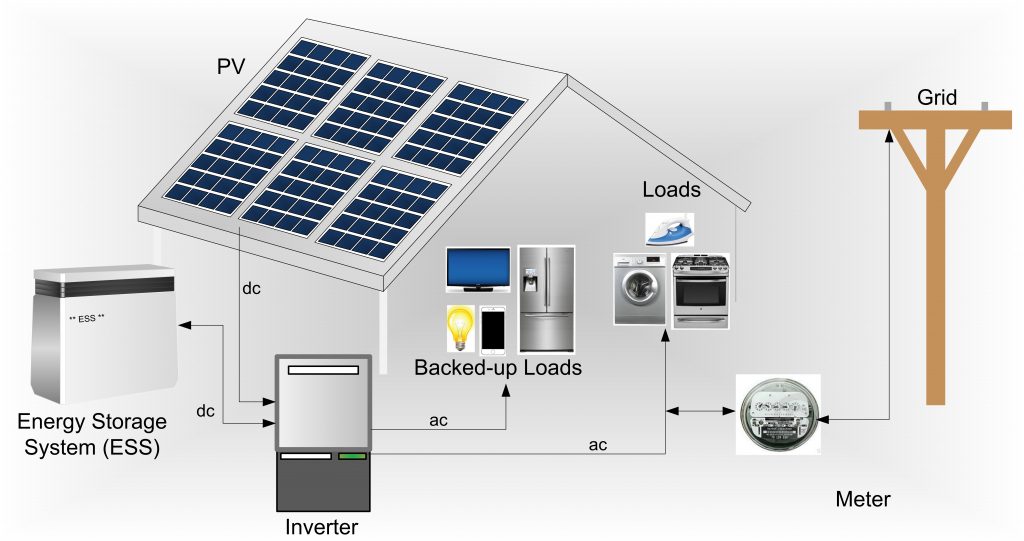
Features
Code File
Codes & Standards
Energy storage systems • Tatjana Dinic
March 14, 2017 | By Tatjana Dinic
 Basic layout of a grid-tied solar PV system with a self-contained energy storage system (ESS).
Basic layout of a grid-tied solar PV system with a self-contained energy storage system (ESS). March 14, 2017 – As the name suggests, energy storage systems (ESSs) are mechanisms capable of storing energy for use at a future time.
These mechanisms could be electrochemical (batteries, which are typical for residential solar PV installations), chemical (hydrogen fuel), mechanical (flywheel systems or compressed air) and thermal. For homes and commercial facilities, ESSs provide the benefit of having electricity available onsite to help reduce peak utility demand and/or usage when generation is unavailable.
With ongoing grid modernization incorporating increased levels of distributed generation and renewable energy sources, we must ensure we’re installing safe home energy storage systems.
Typical ESS configuration
In addition to energy storage, ESSs may include equipment for charging/discharging, control, ventilation, illumination, fire suppression, monitoring and alarms. Battery-based ESSs (which may have AC or DC output) may include battery management systems, inverters and charging equipment.
The layout and configuration of generation systems with an ESS vary based on the specific design and purpose, such as:
• Energy management: time-of-use shifting, peak-shaving capabilities, storing excess electricity production.
• Backup power: automatically provide power to backed-up loads in the event of grid interruption.
ESSs may be designed as self-contained units or composed of individual devices assembled and connected onsite. By their nature, self-contained systems are compact, as all components are enclosed in a single unit, and they are the focus of this column.
Approval and safety
ESSs can store very large amounts of energy, posing a potential fire or shock hazard when handled incorrectly. The short circuit current for lead acid batteries, for example, can be extremely high: 100 to 1000 times the typical discharge current. It is, therefore, crucial these systems be evaluated and tested to ensure safe operation.
CE Code Rule 2-022 requires ESSs to be Approved for use and/or sale in each province/territory (Reg. 438/07 in Ontario). To obtain Approval, manufacturers must engage a certification agency accredited by the Standards Council of Canada, and meet the requirements of ANSI/CAN/UL 9540-16 “Energy storage systems and equipment”. Approved ESSs will bear the Mark of the respective certification agency.
An ESS with batteries is required to have those batteries and its management system tested in accordance to UL 1973 “Standard for batteries for use in light electric rail (LER) applications and stationary applications”.
Rules 84-020 and 14-414 require a disconnecting means to simultaneously disconnect all ungrounded conductors derived from an ESS, and it must be readily accessible (integral with, or adjacent to, the ESS).
In the case of a grid-interconnected ESS, the system must comply with the requirements of CE Code Section 84. Associated inverters (integral within ESSs or installed separately) must be certified and identified as UTILITY INTERCONNECTED (or equivalent).
Each year, energy storage systems become more practical and affordable, and it’s only a matter of time before they become commonplace in homes and commercial facilities. Regulators must be prepared to meet this challenge by ensuring they are equipped with the necessary tools and expertise to ensure ESS installations adhere to all the necessary codes and regulations.
In the U.S., the National Electrical Code (NEC) requires stand-alone ESSs in facilities to be identified with “a permanent plaque or directory installed on the exterior of the building or structure at a readily visible location acceptable to the authority having jurisdiction”. It would be prudent to have similar requirements introduced in the next edition of CE Code.
* This article also appears in the March 2017 edition of Electrical Business Magazine. Check out our ARCHIVE page for back issues.
Tatjana Dinic is the acting director for Engineering & Program Development at Electrical Safety Authority (ESA) where, among other things, she is responsible for product safety, code development, improving harmonization and alternative compliance, and aging infrastructure programs. She is Professional Engineer with an M.Eng. from the University of Toronto, and a member of CE Code-Part I, Sections 4, 10, 30 and 68. She can be reached at tatjana.dinic@electricalsafety.on.ca.
Print this page